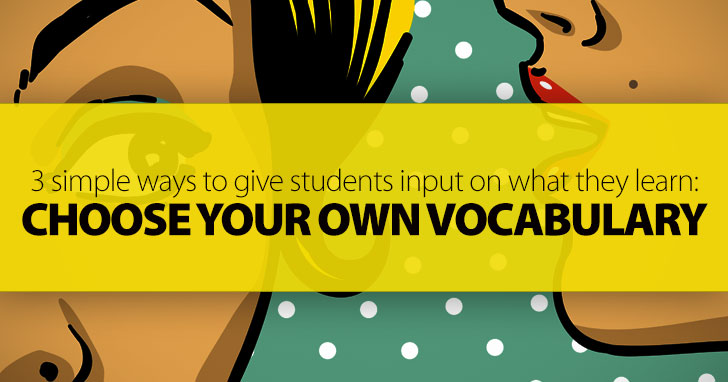Where Does It All Come from? 5 Easy Ways to Develop a Vocabulary Unit from Scratch


Even if someone knows all the rules of pronunciation and grammar, without knowing what individual words mean, they will not be able to communicate with other English speakers. Perhaps that is why vocabulary is such a big part of any ESL class. Or perhaps it is because there is always new vocabulary to learn. Even native English speakers work hard to increase their vocabularies. It is an inexhaustible subject. Whatever the reason, as an ESL teacher you will teach new words to your students. Sometimes the words are given to you, and sometimes you come up with the vocabulary word lists on your own. If you are doing the latter, you might want to consider involving your students in the process. Here are some ideas of how you can do just that.

Though it is often use for other purposes in the ESL classroom, a K/W/L chart is a good way to get your students’ input when it comes to vocabulary. If you have never done a K/W/L chart with your students, it's really quite easy. Divide your board or paper into three columns. Label the first column K. In this column, you will brainstorm with your students what they already know about a certain topic. Work together as a class. As your students offer what they know about the topic, make note of any grammar or topic specific vocabulary that comes up, and include those words on your chart. You might want to circle or underline any of these words as well. If your students offer information for the chart but don’t know the most efficient way to saying it, you should so feel free to supply the correct words, or lingo. The advantage to coming up with a vocabulary list this way is that students are introduced to the words in context from the start. They are also able to relate these new words to words they already know in meaningful context – what they know about the topic. Now that you have completed the first column with your students, fill out the second column. W stands for what they want to know. This column will contain questions about the topic. You are less likely to come across appropriate vocabulary words here, but it is possible. After you finish the unit, complete the third column. L stands for what your class learned about the topic. You might want students to fill this column out on their own and then hand their work in to you. This way you can see if they are using the vocabulary words comfortably and if so which ones.
It always amazes me when students bring me unfamiliar words they have encountered outside of the classroom. The set of words they bring have great variety, and I often ask students where they chanced upon these words. Often they hear these words on a television show or movie, or they might hear people using them in public. It doesn’t really matter where they hear the word; it just matters that they make note of it and then make efforts to learn it. You can use the natural encounters your students have with unfamiliar words to your advantage. Instead of keeping the word themselves, encourage your students to share these interesting and unusual words with the class via a vocabulary bulletin board. That is, when students run across words they do it know, make a way for them to share with the class. Designate one bulletin board in your class for unexpected word encounters. Keep a supply of paper strips near it along with some markers. You might even title the bulletin board “Word Encounters”. Then when students run across a new word either in conversation, the media, or other another venue, have them write the word on one of the strips of paper and post it on the board. Give your students a chance to show what they know on the bulletin board by writing the definition or meaning of a posted word on another slip of paper and posting it under the original word. Just having these words displayed in your classroom will give your students a chance to learn them. But you can also collect the words periodically and compile them into a vocabulary list. Then use these words as one of your vocabulary units. Your students will already have seen them posted in your classroom, and that will give them a leg up when it comes to gaining academic knowledge of the words on your new vocabulary list.
A picture is another good source for coming up with vocabulary, and you can invite your students to share what they see as part of your vocabulary development process. You can use pictures to generate a vocabulary list with your students two different ways. One way involves your entire class in one brainstorm session. Show a picture to your entire class. The picture should relate to whatever thematic unit you are planning on teaching. Then have your students brainstorm words that they know that are related to ten picture. It may be objects or actions they see in the picture or others that relate to what is happening in this particular picture. Write these words on the board as your students offer them. You might also want to encourage your students to use their bilingual dictionaries for this activity. They can look up words that they do not know in English but are still related to the picture. List all the vocabulary your students come up with, and feel free to add your own ideas. You can also feel free to define new words or explain the small differences between words they might find in their dictionaries. Once the brainstorm is complete, choose your final vocabulary list from the collection on the board.
A second way to generate vocabulary lists from picture is to have students work in small groups. Give each group of around four students their own picture. Make sure all the pictures relate to the same topic. Have each group work together to come up with their own list of words related to the picture. Then compile all the lists together. Since you are using multiple pictures in this exercise, you may get a more diverse set of vocabulary than you would from only one picture. Either way, this exercise is particularly interesting when one or more of your students is very knowledge the topic in the picture.
When students have input into what they learn in class, they take ownership of the material. This motivates them to learn it better, and it naturally becomes a part of their English knowledge. Why not let your students have a hand in your next vocabulary list and see what happens?
What other ways have you used successfully? Please share them in the comments section below.